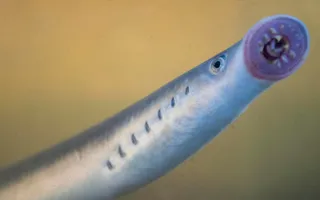River lamprey and our canals
An unusual parasitic fish with an eel-like body, river lampreys are a freshwater species that live in riverbed sediments as larvae and estuaries as adults.
River lampreys are not fished for in the UK.
How to identify a river lamprey
Adult river lampreys are eel-like in size and shape, but they have no gill plates, paired fins or jaws in their mouth – instead, they have breathing holes behind the eyes. They’re silver in colour with uniform grey dorsal and silvery flanks.
The river lamprey can be distinguished from the brook lamprey by its small teeth in the mouth.
Lifecycle of a river lamprey
Just like the much larger sea lamprey, river lamprey are migratory. They spawn in clean, sandy gravels in rivers. They move stones to create depressions in which to lay their eggs. After spawning, they die.
The young larvae then swim off to the soft marginal silt of the river to grow, feeding on the algae, bacteria and detritus. They can spend about five years in the mud before metamorphosing into adults and migrating down to the sea. There, they will feed parasitically on fish, like herring, by attaching themselves with their sucker-like mouths.
Where to find river lamprey
Juvenile river lampreys spend their time in the mud at the riverbed, so you won't see them. However, you might spot adults migrating upstream during the winter to spawn in April and May.
Threats to river lamprey
River lampreys are a rare and protected species in the UK, covered by a number of designations:
- Listed on the International Union for Conservation of Nature (IUCN) Red List of Threatened Species
- Listed on Annex III of the Bern Convention and Annex II of the European Commission Habitats Directive (3)
- Special Area of Conservation (SAC) Annex II species at a number of sites
- Protected under the Salmon & Freshwater Fisheries Act, 1975 (as amended)
River lampreys are not fished for in the UK.





